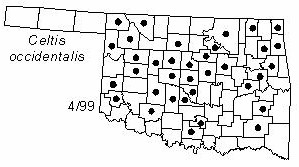Tree to 18 m (60 ft) tall and 60 cm (2 ft) in diameter with a spreading irregular crown. Bark gray to light brown, smooth with corky warts or ridges, becoming rough and scaly on old trunks. Twigs thin, brown soon becoming glabrous. Buds pointed, light brown, with 4 scales, no terminal bud. Leaves alternate, ovate, 5-11 cm (2-4.4 in) long and 2.5-5 cm (1-2 in) wide, sharply serrate, usually shiny green above, paler beneath. Fruits on stalks at leaf bases, 6-10 mm (0.25-0.4 in) in diameter, orange to purple, dry and sweet with one large seed, ripening in Fall.
Distribution: Native to much of the eastern half of the U. S. except for the Coastal Plain.
Habitat: Mostly floodplain and mesic upland forests.
NWI status: FAC
Comment: In central and west-central Oklahoma, where several species and varieties of Celtis occur together, numerous individual trees have characteristics of two or more of the taxa. Identification of a particular tree in this area is often difficult or impossible. The fruits are eaten by squirrels and many species of birds. Celtis is a name given by Pliny to some plant with sweet berries; occidentalis means western (eastern North America was "western" to Linnaeus).
Distribution in Oklahoma: 
BACK
NEXT
RETURN TO INDEX
Last update: 9/9/99
 Go to Oklahoma Biological Survey Home Page
Go to Oklahoma Biological Survey Home Page
 Disclaimer
Disclaimer